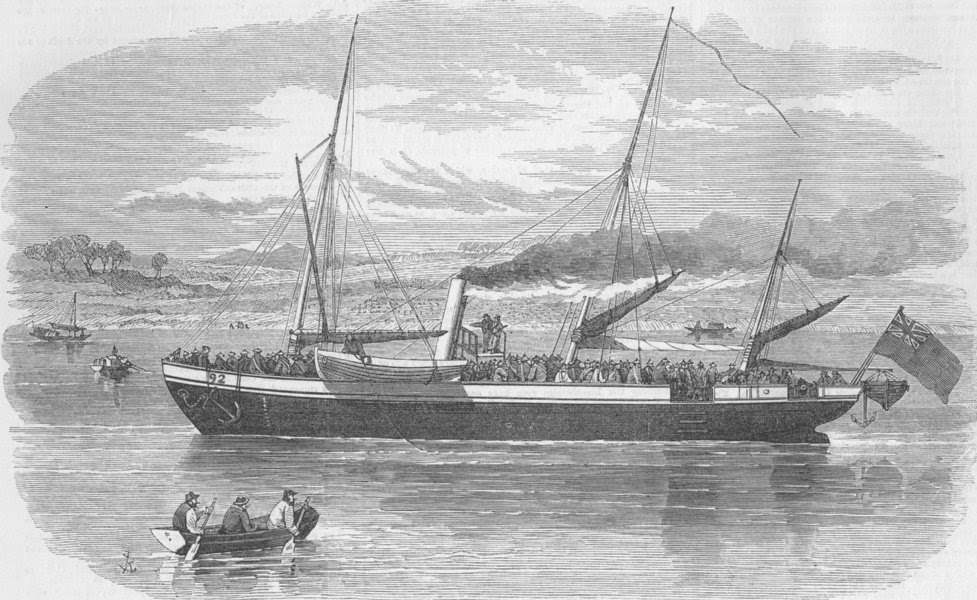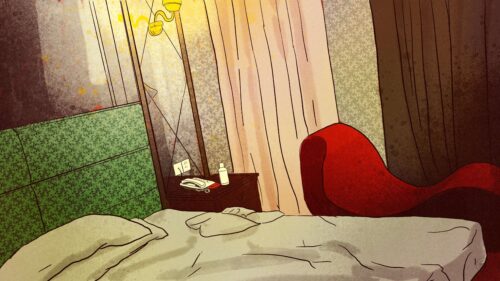This Week in China’s History: October 8, 1856
“The Second Opium, or Arrow, War: 1856-1860.” The designation is common in world history chronologies. Often taken for granted amid the big picture of British imperialism and Qing decline in the 19th century is the incident that set off this Second Opium War. Simply put, on October 8, 1856, Qing officers seized and boarded the vessel Arrow at anchor in Canton harbor.
Understanding the story of the Arrow requires sifting through the motives of the British and the Qing sides, neither of which was satisfied with the outcome of the First Opium War, more than a decade earlier. Historian John Wong did just that in his thorough analysis of the Second Opium War, Deadly Dreams, exploring how it was that this small ship became synonymous with a war that established the height of British imperialism in China.
The Arrow was a lorcha — a hybrid ship design with a European-style hull and Chinese rigging — that worked the southern Chinese coast and Pearl River Delta, calling at ports like Guangzhou, Hong Kong, and Macao. Arriving at Guangzhou on October 3, she sat there for a few days until the local authorities received a tip identifying one of her crew as a pirate who had just taken part in a skirmish a few days earlier. In response, Yè Míngchēn 叶名琛, the top Qing official in Guangzhou, ordered his police to board the Arrow and apprehend the crew.
Ye felt he was seizing a Chinese vessel as part of his ongoing campaign against piracy, but British officials argued that it was a violation of the Treaty of Nanjing, with British Consul Harry Parkes writing to the Governor of Hong Kong (reproduced in John Wong’s book):
“Shortly after 8 o’clock, a Chinese war boat boarded an English lorcha, the Arrow, lying at anchor…and regardless of the remonstrance of her master, an Englishman, seized, bound, and carried off twelve of her Chinese crew, and hauled down the English colors which were then flying.”
Offended, Parkes demanded the immediate return of the vessel and her crew.
As viceroy of Guangdong and Guangxi, Ye Mingchen was a critical point of contact between two empires in conflict. His resume fit the position. He had passed the highest level of the Qing civil service examinations, rising to the prestigious Hanlin Academy, a think tank that was reserved for the top graduates. Experienced and competent, Ye had a perspective on the incident quite different from that of the British. The vessel was Chinese owned, Chinese registered, and crewed entirely by Chinese: no foreigners were on the Arrow at the time Qing officers boarded her. This was strictly an internal matter.
Described in John Wong’s biography, Ye’s previous interactions with the British foreshadowed this conflict. One of the unresolved issues of the Opium War had been access to Guangzhou, China’s most important port. The Qing government lauded Ye for keeping foreigners out of the city, and the British authorities fumed for exactly the same reason. His portfolio grew through the 1850s as he fought rebels, pirates, and smugglers…as well as the British…in southern China. In her book The Opium War, historian Julia Lovell describes Ye as “a busy man, and the piratical Arrow was a part of the general climate of lawlessness pervading the south.”
Piratical?
The Arrow’s identity is at the heart of the conflict between the Qing and the British. Although the Arrow had been registered in Hong Kong, the registration had expired. Moreover, the most grievous charge against the Chinese — that they had taken down the Union Jack — was quickly disproven. And Thomas Kennedy, the British captain of the vessel, had not been on board.
From Ye Mingchen’s perspective, the Arrow was a Chinese pirate ship, and he was accustomed to dealing with pirates: Lovell wrote that Ye executed “tens of thousands of local rebels” as part of his campaign against piracy in the 1850s, and seizing the Arrow’s crew as pirates was standard procedure.
The involvement of the British, though, made the situation far from standard. Confronted with demands to return the crew, Ye soon offered to return almost all of them, detaining just the two had been positively and specifically identified as criminals. Even this was generous on Ye’s part — the whole crew were likely pirates, or at least smugglers. Records suggest that Parkes was aware both that the Arrow’s Hong Kong registration had lapsed and also that none of the arrested sailors were British subjects. And the British captain? Notwithstanding that he was Irish, not English as Parkes suggested, Kennedy’s role was nominal: he seemed to have played little role in the ship’s operation but was employed to provide a plausible claim that the Arrow enjoyed British protection.
So, Ye Mingchen had the law on his side, and the British officials seemed to know it: the Arrow’s status — both national and legal — was at best ambiguous. Yet, as Robert Bickers put it in his survey, The Scramble for China, “the Arrow incident escalated surely, swiftly, smoothly into catastrophic, ghastly violence.” Parkes rejected Ye’s offer, instead demanding a formal apology while he drafted plans for war.
Why?
Obviously, the dispute over a low-stakes lorcha could have been resolved if the British authorities wanted to. They didn’t. What they wanted was a war, one that would settle some of the unresolved issues from the last war.
The first of these was a small semantic point that both Parkes and Ye Mingchen had dug in on. Whereas the Chinese text of the Treaty of Nanjing specified that the British could gain access to the “port” (港口 gǎngkǒu) of Guangzhou (and other treaty ports), the English-language text gave the British the right to reside in the designated “cities and towns.” This was particularly a sticking point in Guangzhou: the British already had access to the port, so from their point of view, the war had changed nothing. British traders wanted access to the city, and Ye Mingchen was equally determined to maintain the status quo. For 15 years, the standoff had persisted.
The second issue was opium, right there in the name of the war, but unmentioned in the treaties ending it. Attempts to revise the treaties to legalize the trade had gone nowhere. Opium selling had been illegal all along, and smuggling was nothing new, but traders now wanted to bring their profits into the open and avoid the potential hassles that illegality brought.
To solve these issues, Parkes and Bowring wouldn’t let a casus belli slip past them, not even one as feeble as the Arrow. A string of ultimatums ratcheted up the stakes: a Chinese vessel was seized, then a Qing fort, and finally Guangzhou itself came under fire from the Royal Navy. By the end of October, the Guangzhou waterfront — including Ye Mingchen’s office — was a smoldering ruin (to underscore the point, the site of Ye’s yamen was rebuilt after the war with a French Roman Catholic church).
The consequences of this Second Opium War were far-reaching. The opium trade was legalized. Access to Guangzhou, and another dozen cities across China, was assured. As the war ended, French and British troops burned and looted Beijing’s Summer Palace in what came to symbolize China’s “Century of Humiliation.”
But to refocus from the global to the local, it is the fate of Ye Mingchen that to me captures the Arrow incident. After standing up to the British for a decade, Ye’s fate was sealed in the first days of the Arrow war. Fleeing naval bombardment, Ye was taken captive by his longtime adversary, Parkes. Reversing the path of the opium traders that had precipitated his fall, Ye was taken from Hong Kong to India, held as a prisoner of war in Calcutta. Finally unable to stop the British advance, he could in the end bear it no more, dying in a hunger strike in 1859.
The “Century of Humiliation” has today become a cliche and a CCP talking point, but it’s worth remembering that for many, it has been both personal and very real.
This Week in China’s History is a weekly column.






